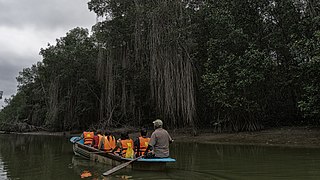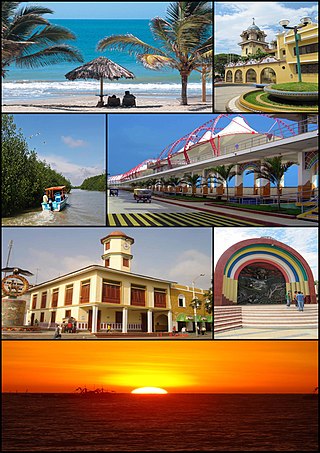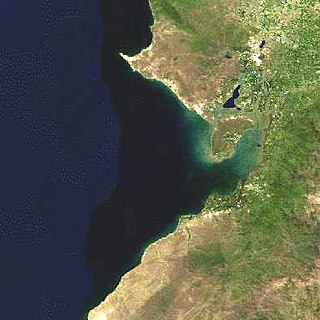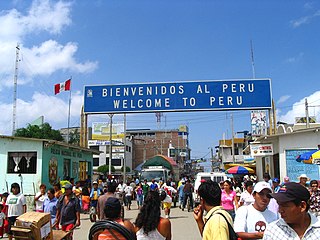
Ecuador, officially the Republic of Ecuador, is a country in northwestern South America, bordered by Colombia on the north, Peru on the east and south, and the Pacific Ocean on the west. Ecuador also includes the Galápagos Islands in the Pacific, about 1,000 kilometers (621 mi) west of the mainland. The country's capital is Quito, but its largest city is Guayaquil.

Tumbes is a coastal department and region in northwestern Peru bordering Ecuador. Due to the region's location near the Equator it has a warm climate, with beaches that are considered among the finest in Peru. Despite its small area, the region contains a wide variety of ecosystems. It is the smallest department in Peru and its third least populous department after Moquegua and Madre de Dios, but it is also its third most densely populated department, after La Libertad and Lambayeque.

Tumbes is a city in northwestern Peru, on the banks of the Tumbes River. It is the capital of the Tumbes Region, as well as of Tumbes Province and Tumbes District. Located near the border with Ecuador, Tumbes has 111,595 inhabitants as of 2015. It is served by the Cap. FAP Pedro Canga Rodriguez Airport. It is located on the Gulf of Guayaquil along with Zorritos.

The Second Ecuadorian–Peruvian War, known locally as the War of '41, was a South American border war fought between 5–31 July 1941. It was the first of three military conflicts between Ecuador and Peru during the 20th century.

Tumbes is a province in Peru, located in the region of the same name. It borders the Pacific Ocean on the north, the Zarumilla Province on the east, the Piura Region and Ecuador on the south and the Contralmirante Villar Province on the west. Its capital is Tumbes, which is also the regional capital.

Zarumilla is one of the three provinces of the Tumbes Region in northwestern Peru. It borders the Pacific Ocean on the north, Ecuador on the south and east, and the Tumbes Province on the west.

Zarumilla is a city in the Tumbes Region, in northwestern Peru. It has a population of 54,625 as of 2019, and is the capital of the Zarumilla Province. It is also the main settlement in the Zarumilla District. It is located only a few kilometers away from the border town of Aguas Verdes, which is connected to Ecuador by a bridge.

The Zarumilla River is a river in South America that marks the border between Peru and Ecuador. It is named after the Peruvian town of Zarumilla.

The Gulf of Guayaquil is a large body of water of the Pacific Ocean in western South America. Its northern limit is the city of Santa Elena, in Ecuador, and its southern limit is Cabo Blanco, in Peru.

Huaquillas is a border town in western El Oro, Ecuador. It is the canton seat of the Huaquillas Canton.

The Ecuadorian–Peruvian territorial dispute was a territorial dispute between Ecuador and Peru, which, until 1928, also included Colombia. The dispute had its origins on each country's interpretation of what Real Cedulas Spain used to precisely define its colonial territories in the Americas. After independence, all of Spain's colonial territories signed and agreed to proclaim their limits in the basis of the principle of uti possidetis juris, which regarded the Spanish borders of 1810 as the borders of the new republics. However, conflicting claims and disagreements between the newly formed countries eventually escalated to the point of armed conflicts on several occasions.

The Paquisha War, Fake Paquisha War or Third Ecuadorian-Peruvian War was a military clash that took place between January and February 1981 between Ecuador and Peru over the control of three watchposts. While Peru felt that the matter was already decided in the Ecuadorian–Peruvian War of 1941, Ecuador claimed that the Rio de Janeiro Protocol was not executable because a 78 km section of the border was not precisely defined.

Aguas Verdes is a district in the Zarumilla Province of the Tumbes Region in northwestern Peru. Its capital is the town of Aguas Verdes, which is on the banks of the Zarumilla River. Located on the border with Ecuador, Aguas Verdes serves as the largest international point of entry in Peru's northern border. This district is located right across the river from the Ecuadorian town of Huaquillas.

Tumbes is a district in the middle Tumbes Province in Peru. It is bordered by Corrales District on the west, Pacific Ocean on the north, Zarumilla Province on the east, and San Juan de la Virgen District on the south.
The military history of Ecuador spans hundreds of years.

The Tumbes–Piura dry forests (NT0232) is an arid tropical ecoregion along the Pacific coasts of southern Ecuador and northern Peru. The ecoregion contains many endemic species of flora and birds adapted to the short wet season followed by a long dry season. Threats include extraction of wood for fuel or furniture, and capture of wild birds for sale.

The Battle of Zarumilla was a military confrontation between Peru and Ecuador that took place from July 23 to 31 during the 1941 Ecuadorian–Peruvian War.

Club Deportivo Comercial Aguas Verdes is a Peruvian football club, playing in the city of Zarumilla, Zarumilla, Peru.
Club Social Deportivo Ferrocarril is a Peruvian football club, playing in the city of Zarumilla, Tumbes, Peru.

The Monument to the Defenders of the Border is a commemorative sculptural complex located in the Campo de Marte in Lima, Peru. Its author was the Peruvian sculptor Artemio Ocaña. It was erected between 1944 and 1945 in honor of those who fell during the Ecuadorian–Peruvian War of 1941.


















